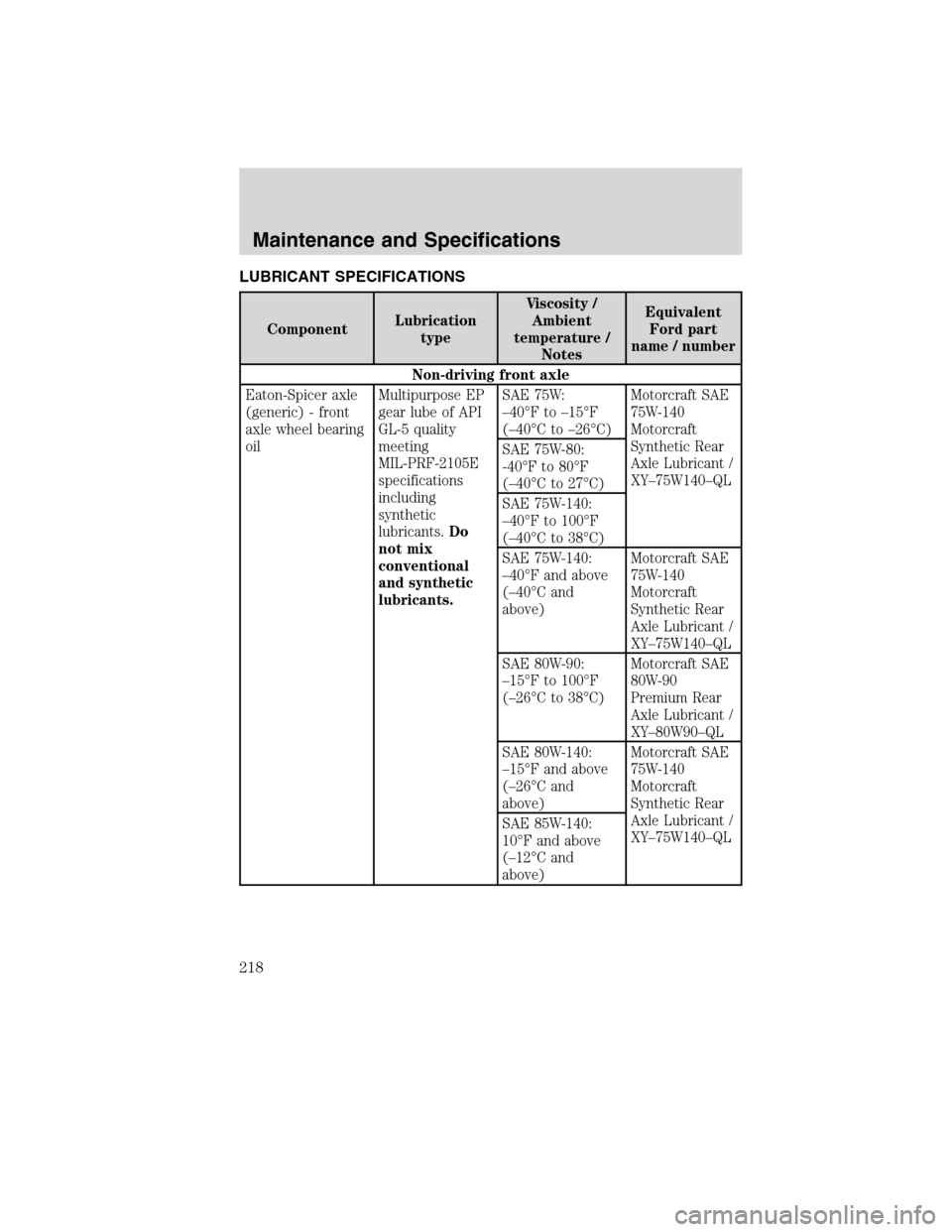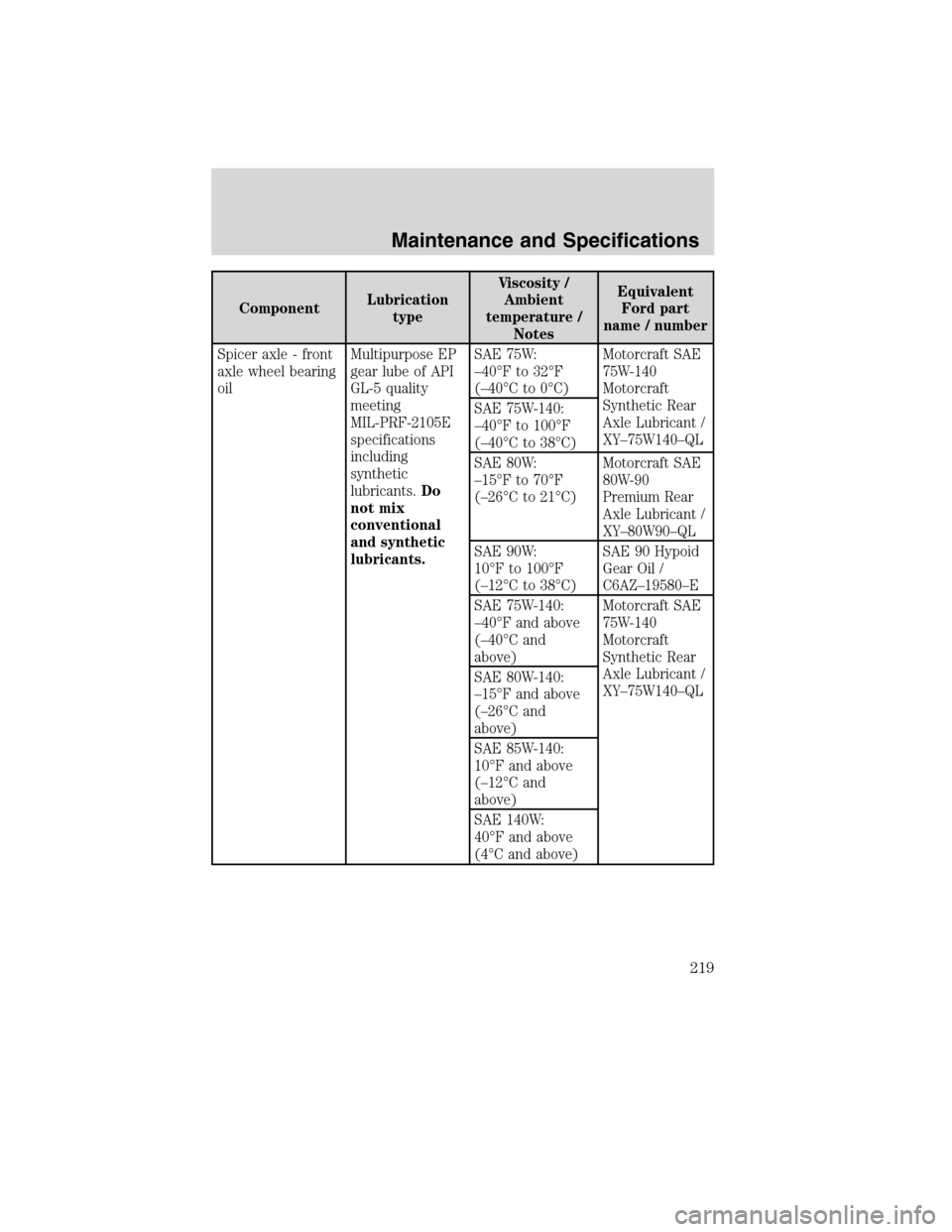Page 215 of 274

Proper tire inflation, toe-in adjustment, loads, and road speeds are
important factors governing tire mileage, steering ease and maneuverability.
Loads
WARNING:Loading tires beyond their rated capacity decreases
tire life requiring more frequent replacement of tires.
Overloading creates an unsafe condition that may result in sudden air
loss from a tire failure resulting in an accident that could cause
property damage, personal injury or death.
Note:Your GAW/GVW rating is correct at the time of your vehicle
production, and reflects the exact rating of the tires specified. When
replacing tires be sure that the replacement tire load rating (listed in
pounds and kilograms on the tire sidewall) is the same or higher than
the tire that is removed. Failure to do so will adversely affect maximum
load carrying capacity. Tires with the same size specification do not
always have the same load specification.
Matching
Dual Tires:Dual tires should be matched using tires of equivalent size.
Tires which differ more than
1�4inch (6 mm) in diameter or3�4inch
(19 mm) in circumference should not be mounted on the same dual
wheel assembly.
Mixing:Never mix bias and radial tires on this vehicle. Never mix
different tire sizes or constructions on the same axle.
Rotation:
Rotation is always advisable:
1. If front (steering) axle tires become irregularly worn, move to rear
position.
2. In a dual assembly, reverse the position of the tires if one tire wears
much faster than its mate.
3. On the drive axle, if heel and toe wear or alternate lug wear occurs,
rotating the tires from one end of the axle to the other end of the axle
may help even out this wear.
Rotation may not advisable:
1.Front (Steering) Axle:Tires must be removed when tread is worn
to 4/32 inch (3 mm) or less. Retread or rotate worn tires to drive
position. Retreaded tires are not recommended to be used on steering
axles.
Maintenance and Specifications
215
2010 F-650/750(f67)
Supplement(supplement), 1st Printing
USA(fus)
Page 216 of 274

2.Rear Axles:Tires must be removed when tread is worn to 2/32 inch
(2 mm).
If rib tire is used on front axle and lug or off-road type on rear axle
positions:
1.Front (Steering) Axle:Replace tires at front wheels when tread is
worn to 4/32 inch (3 mm) or less.
2.Rear Axles:Tires must be removed when the tread is worn to
2/32 inch (2 mm) or less. Tires identified with the word “re-groovable”
molded on the sidewall can be re-grooved. A minimum of 3/32 inch
(2.5 mm) of under-tread must be left at the bottom of the grooves.
Wheel and tire balancing
Out-of-round or out-of-balance wheels or tires can cause vehicle
vibration, bounce and shimmy. Replace damaged or out-of-round wheels.
Out-of-round tires and wheel assemblies can be corrected by re-clocking
the tire relative to the wheel.
The tire and wheel assembly should then be dynamically balanced.
Wear
Radial tires can exhibit three types of normal wear patterns: 1) Even, 2)
Erosion, 3) Chamfer.
Even wearis a sign that the tire is being properly used and maintained.
Erosion wearhas also been called rolling wear, channel or river wear.
Erosion wear is found more often at free rolling tires. This is an
indication that the tire is being used in a slow wearing operation. What
happens is that the belt plies are held very rigid and the tread is not
allowed to distort as it passes through the contact area. Wear will only
occur at the edge of the tread. No corrective action required. If erosion
gets to be 1/16 inch (2 mm) or more, the tire may be rotated to a drive
axle.
Chamfer or shoulder wear,with tires inflated properly, is a normal
tendency of most radial tire designs. If both inside and outside shoulders
are wearing evenly around the tire, no further action is required.
Over-inflation is not effective in correcting this effect.
Tires: Irregular Wear
If irregular wear is present, check the axle alignment, tire pressure,
wheel balancing, shock and suspension component condition, and wheel
bearing end play.
This condition not only shortens tire life, but will adversely affect the
handling of your vehicle, which is dangerous.
Maintenance and Specifications
216
2010 F-650/750(f67)
Supplement(supplement), 1st Printing
USA(fus)
Page 217 of 274

Rotating tires from one wheel position to another is a way often used to
even out many types of irregular wear or to avoid it altogether. Some of
the more effective tire rotation programs are:
•Steer tires that have developed some type of irregular wear pattern
can be rotated to drive axles if rib tires are being used on all wheel
positions. Applying steer tires to a drive position will often clean them
and they can be moved back to the steer axles or run out to re-tread
stage on the rear axle.
•Another rotation possibility for fleets with rib tires in all wheel
positions is to break in the new steer tires in the drive axle positions,
then move them to steer axles. This will wear away tread rubber
relatively quickly in the early life of a tire when it is most likely to
develop an unusual wear pattern.
•Drive axle tires may be placed on the other end of the same axle so
that direction of rotation is reversed. This is often helpful if a heel and
toe or alternate lug wear pattern has developed.
Irregular wear can be minimized by:
•Using the right inflation pressure for the load being carried.
•Maintaining proper front wheel alignment -especially toe-in-to
specifications.
•Maintaining proper tire and wheel balance.
•Maintaining shock absorbers and suspension components.
Use of tire chains
Refer to chain manufacturer’s recommendation for correct tire chain
usage, installation and removal.
Maintenance and Specifications
217
2010 F-650/750(f67)
Supplement(supplement), 1st Printing
USA(fus)
Page 218 of 274

LUBRICANT SPECIFICATIONS
ComponentLubrication
typeViscosity /
Ambient
temperature /
NotesEquivalent
Ford part
name / number
Non-driving front axle
Eaton-Spicer axle
(generic) - front
axle wheel bearing
oilMultipurpose EP
gear lube of API
GL-5 quality
meeting
MIL-PRF-2105E
specifications
including
synthetic
lubricants.Do
not mix
conventional
and synthetic
lubricants.SAE 75W:
–40°F to –15°F
(–40°C to –26°C)Motorcraft SAE
75W-140
Motorcraft
Synthetic Rear
Axle Lubricant /
XY–75W140–QL SAE 75W-80:
-40°F to 80°F
(–40°C to 27°C)
SAE 75W-140:
–40°F to 100°F
(–40°C to 38°C)
SAE 75W-140:
–40°F and above
(–40°C and
above)Motorcraft SAE
75W-140
Motorcraft
Synthetic Rear
Axle Lubricant /
XY–75W140–QL
SAE 80W-90:
–15°F to 100°F
(–26°C to 38°C)Motorcraft SAE
80W-90
Premium Rear
Axle Lubricant /
XY–80W90–QL
SAE 80W-140:
–15°F and above
(–26°C and
above)Motorcraft SAE
75W-140
Motorcraft
Synthetic Rear
Axle Lubricant /
XY–75W140–QL SAE 85W-140:
10°F and above
(–12°C and
above)
Maintenance and Specifications
218
2010 F-650/750(f67)
Supplement(supplement), 1st Printing
USA(fus)
Page 219 of 274

ComponentLubrication
typeViscosity /
Ambient
temperature /
NotesEquivalent
Ford part
name / number
Spicer axle - front
axle wheel bearing
oilMultipurpose EP
gear lube of API
GL-5 quality
meeting
MIL-PRF-2105E
specifications
including
synthetic
lubricants.Do
not mix
conventional
and synthetic
lubricants.SAE 75W:
–40°F to 32°F
(–40°C to 0°C)Motorcraft SAE
75W-140
Motorcraft
Synthetic Rear
Axle Lubricant /
XY–75W140–QL SAE 75W-140:
–40°F to 100°F
(–40°C to 38°C)
SAE 80W:
–15°F to 70°F
(–26°C to 21°C)Motorcraft SAE
80W-90
Premium Rear
Axle Lubricant /
XY–80W90–QL
SAE 90W:
10°F to 100°F
(–12°C to 38°C)SAE 90 Hypoid
Gear Oil /
C6AZ–19580–E
SAE 75W-140:
–40°F and above
(–40°C and
above)Motorcraft SAE
75W-140
Motorcraft
Synthetic Rear
Axle Lubricant /
XY–75W140–QL SAE 80W-140:
–15°F and above
(–26°C and
above)
SAE 85W-140:
10°F and above
(–12°C and
above)
SAE 140W:
40°F and above
(4°C and above)
Maintenance and Specifications
219
2010 F-650/750(f67)
Supplement(supplement), 1st Printing
USA(fus)
Page 220 of 274

ComponentLubrication
typeViscosity /
Ambient
temperature /
NotesEquivalent
Ford part
name / number
Eaton-Spicer axle,
Spicer axle - Front
axle wheel bearing
grease, tie rod
ends, drag link,
kingpin and
bushingEP2 Lithium
complex-based
moly grease (or
equivalent)
GC/LB NLGI #2
multi-purpose
lithium complex
greaseNote:
Eaton-Spicer and
Meritor Easy Steer
axles: With chassis
load on axle, force
grease through
thrust bearings;
then with axle
lifted clear of the
floor, force grease
between kingpin
and bushing
surfaces.Motorcraft
Premium Long
Life Grease /
XG-1-C
Steering
Power steering
fluidMERCON�V
Automatic
Transmission
Fluid— MERCON�V/
XT-5-QMC
Steering gear Ross
TAS - Output SealGC/LB NLGI #2
lithium
complex-based
moly grease or
multi-purpose
lithium complex
grease— Motorcraft
Premium Long
Life Grease /
XG-1-C
Steering column
U-joints / slip jointGC/LB NLGI #2
lithium
complex-based
moly grease or
multi-purpose
lithium complex
grease— Motorcraft
Premium Long
Life Grease /
XG-1-C
Maintenance and Specifications
220
2010 F-650/750(f67)
Supplement(supplement), 1st Printing
USA(fus)
Page 221 of 274
ComponentLubrication
typeViscosity /
Ambient
temperature /
NotesEquivalent
Ford part
name / number
Driveshaft
U-joint GC/LB NLGI #2
lithium
complex-based
moly grease or
multi-purpose
lithium complex
grease— Motorcraft
Premium Long
Life Grease /
XG-1-C
Clutch
Release bearing /
shafts / forkGC/LB NLGI #2
lithium
complex-based
moly grease or
multi-purpose
lithium complex
grease— Motorcraft
Premium Long
Life Grease /
XG-1-C
Reservoir DOT 3,
ESA-M6C25–A or
WSS-M6C62–A— Motorcraft High
Performance
DOT 3 Motor
Vehicle Brake
Fluid, PM-1 or
PM-1–C
Cooling system
Engine coolant Refer to engine operator’s manual
Maintenance and Specifications
221
2010 F-650/750(f67)
Supplement(supplement), 1st Printing
USA(fus)
Page 222 of 274
ComponentLubrication
typeViscosity /
Ambient
temperature /
NotesEquivalent
Ford part
name / number
Windshield washer
Washer fluid WSB-M8B16-A2 — Motorcraft
Premium
Windshield
Washer
Concentrate /
ZC-32-A
Transmission
Eaton-Fuller Petroleum oil:
Engine oil API-SL
or API-CF
(MIL-L-2104E or
MIL-L-46152E)SAE 50:
Above 10°F
(–12°C)—
SAE 40:
Below 10°F
(–12°C)—
Mineral gear oil:
API-GL-1 (rust
and oxidation
inhibited)SAE 80W–90:
Above 10°F
(–12°C)—
SAE 75W:
Below 10°F
(–12°C)—
Synthetic oil:
Eaton�,
Roadranger�
synthetic CD-50
transmission fluidCD SAE 50:
All temperatures—
Maintenance and Specifications
222
2010 F-650/750(f67)
Supplement(supplement), 1st Printing
USA(fus)